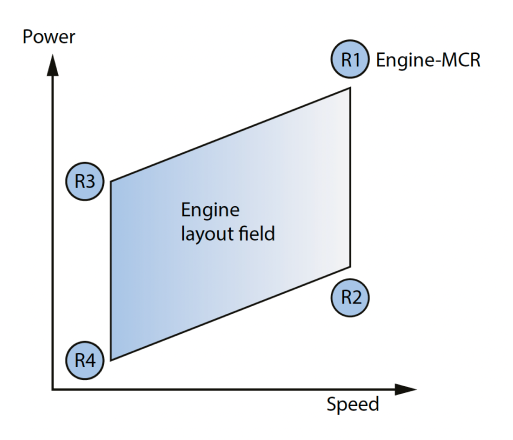Engine definitions
ISO Standard (ISO 3046-1) reference conditions
- 1.0 bar
- Total barometric pressure at R1
- 25°C
- Suction air temperature
- 30%
- Relative humidity
- 25°C
- Cooling water temperature before engine
Rating points
The engine layout fields for WinGD low-speed engines are defined by the power/speed rating points R1, R2, R3 and R4 (see diagram).
R1 is the nominal maximum continuous rating (MCR).
Any power and speed within the respective engine layout field may be selected as the Contracted-MCR (CMCR) point for an engine.

Dimensions and weights
- A
- Engine length from the coupling flange to the end of the bedplate
- A*
- Engine length from the TC aft end to the end of the bedplate
- B
- Width of the engine seating
- C
- Dist. from the centre of the crankshaft to the underside of the foot flange
- D
- Dist. from the centre of the crankshaft to the highest point of the engine
- F1
- Min. height for vertical removal of the piston
- F2
- Min. height for vertical removal of the piston with double-jib crane
- F3
- Min. height for tilted removal of the piston with double-jib crane
- G
- Distance from the centre of the crankshaft to the lowest point of the engine
– The engine weight is a net value and excludes any liquids.
All dimensions and weights are not binding. For detailed information and updates, please visit: https://wingd.com/products-solutions/engines
Fuel/energy consumption
All brake specific fuel consumptions (BSFC) and brake specific pilot fuel consumptions (BSPC) are quoted for fuel of lower calorific value 42.7 MJ/kg.
Brake specific gas consumptions (BSGC) are quoted for gas of lower calorific value 50.0 MJ/kg.
For other fuel types, the following reference lower calorific values are applied:
Brake specific energy consumptions (BSEC) for dual-fuel engines are based on energy delivered to the engine as gas and liquid fuel for one kilowatt hour mechanical power output.
For all WinGD low-speed diesel and dual-fuel engines stepwise tolerances have been introduced for the brake specific fuel and energy consumption (BSFC/BSEC) guarantee, referring to ISO standard reference conditions (ISO 15550 and 3046):
- +5% tolerance for 100% to 85% engine power
- +6% tolerance for <85% to 65% engine power
- +7% tolerance for <65% to 50% engine power
The BSFC/BSEC guarantee is possible at up to three power points between 50–100%.

Available engine tunings
Delta Bypass Tuning and Low-load Tuning are available for certain WinGD low-speed diesel engines to provide optimum fuel consumption for different engine loads. Delta Bypass Tuning and Low-load Tuning focus on reducing fuel consumption in the operating range below 90% or 75% engine power, respectively.
The advanced technology of Steam Production Control (SPC) can be added to the Low-load and Delta Bypass Tuning to increase the steam production, while keeping the overall fuel consumption at a minimum.
Dual tuning is available on request and in cooperation with classification societies.
Automated Sequential Turbocharging (aSTC) is available as an option for X82-2.0 and X92-1.1 engines with multi-turbocharger configurations. aSTC significantly reduces the engine's consumption at low loads.
